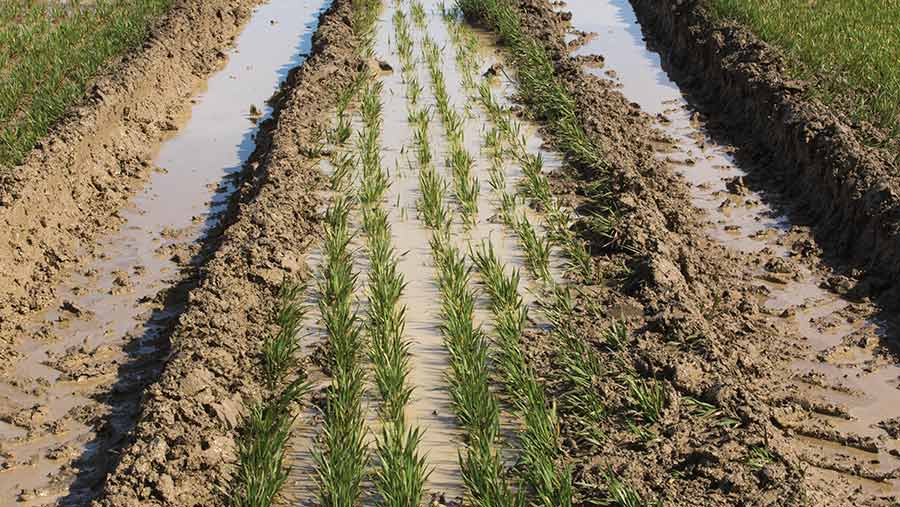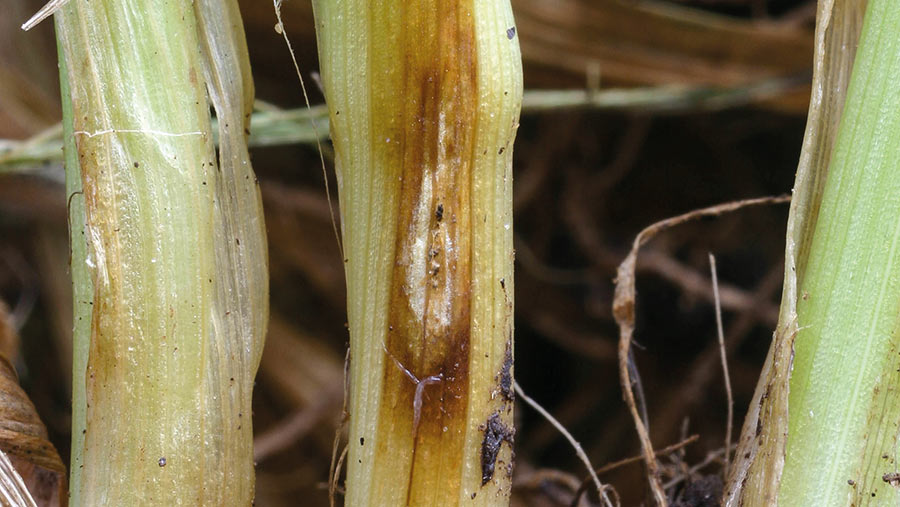Crop Watch: Disease and lodging are priority in soggy spring
 © Tim Scrivener
© Tim Scrivener Easter saw a short respite in the wet weather with growers trying to catch up with drilling, fertiliser spreading and spraying.
While it allowed some jobs to be done, it came too late for clopyralid-based herbicide sprays in OSR.
With T1s just around the corner for winter barley in the north, there is plenty of net blotch, rhynchosporium and brown rust to be found. For wheat, septoria pressure is rising and eyespot is a concern in the west.
See also: How a trickle approach can cut potato irrigation energy costs
North
Conor Campbell
Hutchinsons (Northumberland)
Wet weather throughout March hampered progress in field. Crops that were fortunate enough to receive some early nitrogen prior to the rain were very grateful. Thankfully, a spell of nice weather allowed us back into the fields last week to get, for many, their first dressing of nitrogen on to crops.
Some spring drilling has started in the Scottish Borders, but very little has been done around Northumberland.
However, we are by no means late yet. Last year most spring barley came through in extremely dry conditions, something I doubt will be an issue this year.
Moisture will be plentiful at drilling and should get crops off to a great start.
With everyone poised to make a start on spraying when conditions allow, our attention turns to prioritising what to do first and when.
Personally, I have lodging and disease suppression at the top of my list.
While weed control is extremely important and very visual, in most cases, their impact on yield is far less than lodging or allowing disease to take over.
Septoria pressure varies with sowing date and variety, but with the wet weather you can begin to see the disease on the newer leaves.
As crops are at GS30, attention will turn to a T0 spray. There is much debate around the validity of this timing and how much yield benefit we see.
I think it’s important to consider that it helps to ease the pressure at T1 and is also a good opportunity to improve overall plant development.
Winter barley
Winter barleys have been very grateful for some nitrogen, as they were becoming increasingly easy to pick out from the roadside.
T1 is just around the corner for many, and robust rates will be required, with plenty of net blotch, rhynchosporium and brown rust to be found.
Oilseed rape seems to have missed the memo about the wet conditions, as it continues to shoot for the skies.
The yellow haze of early crops has started to fill the countryside, as we look to travel, for many, with our first fungicide.
Traditionally, we would look to cover these at early stem extension for light leaf spot, but this is now starting to look like an early flowering spray.
Consider product choice if this is your first time through, as I’ve been noticing a lot more disease when walking crops.
South
Iain Richards
Agrii (Oxfordshire)
We’ve hardly drilled an acre and only had a couple of decent spray days in the past month. But, having taken every opportunity to get ahead with our fieldwork in February, the wet March hasn’t been too problematic for all.
Interestingly, even though we had 156mm of rain last month, it has actually only been a slightly wetter start to the year than 2022. And a good soaking has done our winter crops a power of good.
Benefiting more than most have been our frost-lifted cereals, which needed a decent amount of rain to help them make up for poor initial rooting.
Rolled and fertilised in near-perfect February conditions, they have recovered very well.
The faster-growing OSR hybrids have also taken advantage of their early nitrogen to grow away strongly from the winter.
Encouragingly, few plants are carrying significant cabbage stem flea beetle larval burdens, with plant populations so good their contribution is unlikely to be missed.
Planted in February, the bulk of our spring barley is looking good too, despite the greatest slug challenge we’ve seen for a good 10 years and significant crop effect from pre-emergence herbicides.
Areas of trafficked headlands and corners still need to get going as well as we’d like. But, unlike too many other springs, they have plenty enough soil moisture to do so.
Wheat T0s
With leaf four 70% emerged in our earliest drilled wheats, T0s are just going on – a little later than usual.
As septoria levels have been increasing everywhere, we are using more folpet than originally planned to support our most susceptible varieties, as well as upping the rates of our chosen bromuconazole/tebuconazole co-formulation wherever necessary in response to heightened yellow rust concerns.
Patience isn’t always easy in such frustratingly unpredictable weather. But, since we normally apply most of our T1s in the last week of April and T2s by mid-May, the slight delay in T0s has been valuable in setting things up nicely for the three-week spray intervals we want.
OSR coming into stem extension relatively late has been equally useful in a season where early light leaf spot levels have been fairly low.
Stem extension sprays only going on around yellow bud are giving us noticeably more flexibility in the timing of our flowering treatments. And, once again we haven’t needed to even consider a pollen beetle spray.
We continue to grab every single spraying and fertilising opportunity we get – not least to clear the decks for the last of our spring drilling.
Thankfully, we only have 20% of the barley still to go in. This is mainly on heavy ground with particular blackgrass pressure, so a pre-emergence is essential.
It means we are resisting any temptation to drill until we know conditions are good enough for a decent seed-bed and effective rolling.
If we have to sow barley in April, within reason we’ve found it makes little difference. But it has to go in well. And it can’t afford any pre-emergence check. Here again, patience is proving an important virtue.
East
Becky Finbow
Agrovista (Norfolk/Suffolk)
Although there is still a chill in the air, it is nice to see some sunshine.
Unfortunately, a lot of the fields in the East still sit wet and will take some time to dry out before farmers are able to finish off their spring drilling.
On the lighter land the plough/press combinations are busy getting land ready for the sugar beet drill.
This time last year I had already done one post-emergence herbicide spray on most of my beet crops.
The drills may be starting later this season, but it does mean, provided we have some good seed-beds, that crops should emerge and grow quickly.
This will help them reach the vital 12-leaf stage sooner, reducing the time for aphids to infect the crop with virus yellows.
It should also mean the crop will touch in and between the rows earlier, hindering weed germination. Fingers crossed.
Spring crops
Spring barley that was drilled before the rain is now at the two-leaf stage. In a normal year we would be applying a fly spray alongside nutrition but, given the cold weather, Rothamsted Aphid Bulletin has shown no aphid activity as yet.
A lot of winter wheat crops have now had their T0 – depending on the variety this has consisted predominantly of a rust and/or eyespot fungicide, plant growth regulator and nutrition. Walking the winter cereals, very few weeds have been seen yet.
Winter barley T1s are now the priority. Crops are forward this year so while walking for disease and weed pressures it will also be vital to have a rigid plant growth regulator programme in place.
On hybrid feed varieties the programme has already started, with a split dose of trinexapac and chlormequat being applied at T0 stage. The further split will be applied at T1.
On conventional varieties my programme will start at T1 with a very similar mix, provided we have good weather conditions for growth.
West
Stephen Harrison
AICC/Southwest Agronomy (Avon)
It’s been a struggle. Last season’s exact timings and steady applications progress have been metaphorically and physically washed under the bridge.
Crop growth stages have marched on, regardless of the deluge. I fear there will be some ugly thistles in winter OSR come harvest as recommended growth stages for clopyralid-based herbicides slipped by in the rain.
Thankfully, those crops with insect damage I mentioned last month have enough surviving plants to give potential for a reasonable harvest.
Easter weekend did bring some short-lived respite from the deluge, allowing essential fungicide and growth regulator treatments to winter barley.
This crop’s reliance on shoot numbers for yield means late tillering to early stem extension inputs are vital.
Progress has not been so good with the wheat crop. Most crops are at growth stage 30 to 31 so a split dose plant growth regulator programme should still be possible. Extase is the notable exception, where forward crops in early areas have final leaf 3 emerging.
Eyespot concern

Stem bases disease © Blackthorn Arable
We do not seem to have the yellow rust pressure of further east and overall, we are not growing highly susceptible varieties.
Eyespot is of concern and thicker crops drilled in early to mid-October will require specific targeting.
I fear the chances of a low-cost final leaf 3 treatment, later in April, are bleak, a prospect not helped by some eyewatering fungicide price increases.
Spring drilling progress is slow. Heavier land where we took advantage of dry February conditions is swamp-like. In the wettest areas spring beans have been lost.
One benefit from the wet March has been the performance of spring-applied cereal graminicides.
Yes, we have a few live blackgrass plants among controlled ones, but control has been just about acceptable.
Adequate moisture supply (a bit of understatement) and little stress on the crop meant there were no obvious phytotoxic effects.

